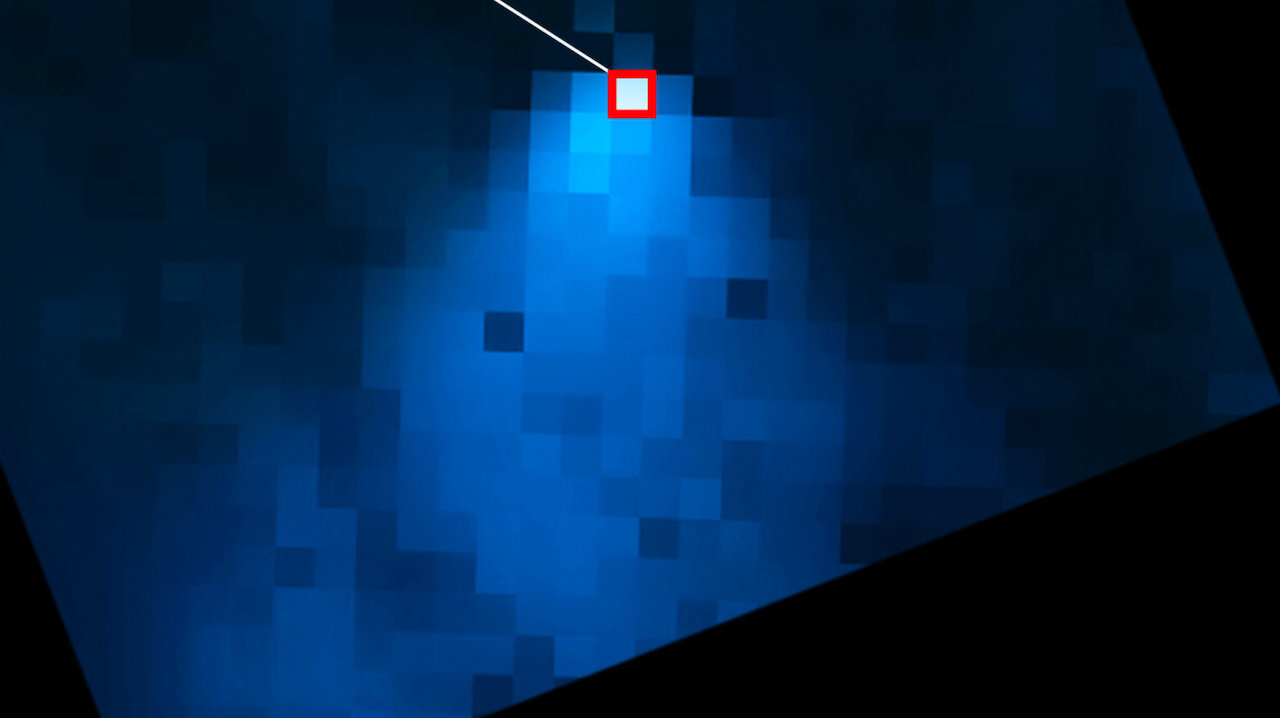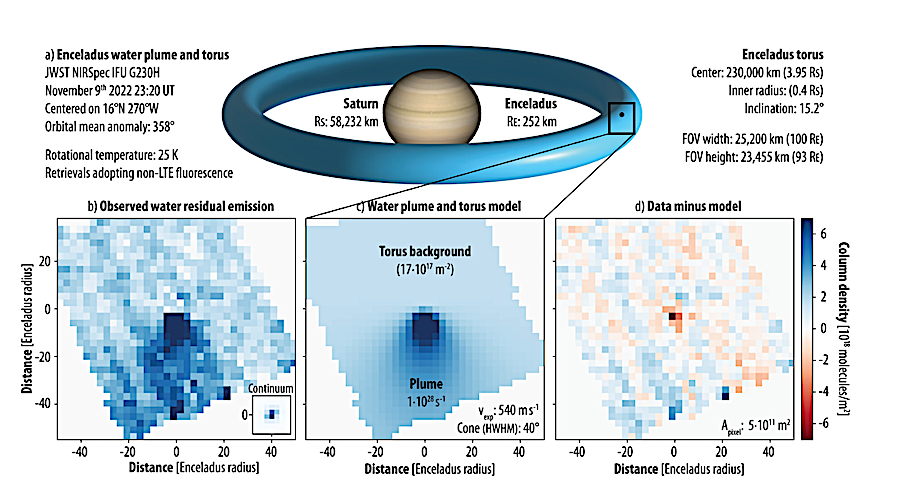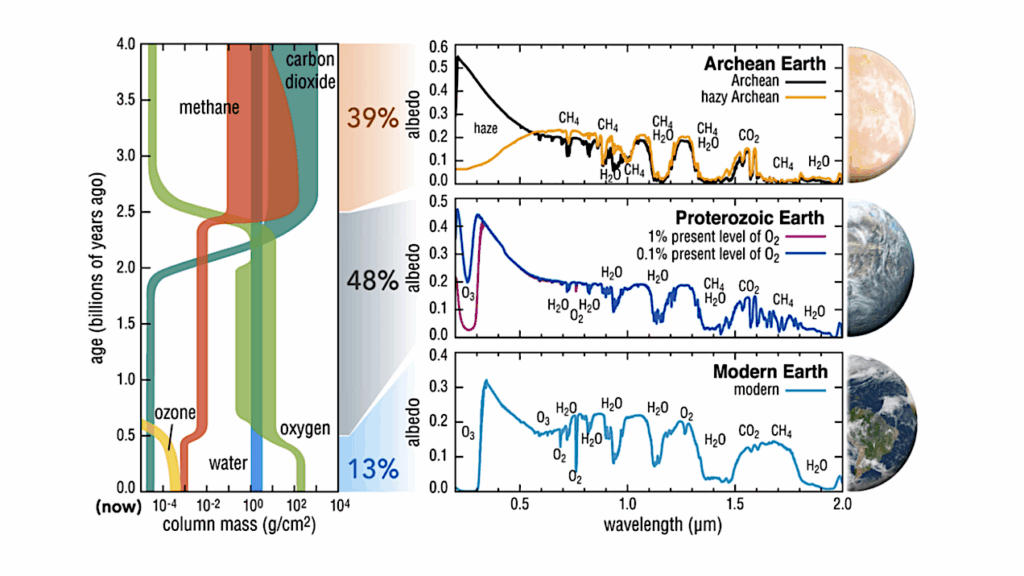JWST Molecular Mapping And Characterization Of Enceladus’ Water Plume Feeding Its Torus

Enceladus is a prime target in the search for life in our solar system, having an active plume likely connected to a large liquid water subsurface ocean.
Using the sensitive NIRSpec instrument onboard JWST, we searched for organic compounds and characterized the plume’s composition and structure. The observations directly sample the fluorescence emissions of H2O and reveal an extraordinarily extensive plume (up to 10,000 km or 40 Enceladus radii) at cryogenic temperatures (25 K) embedded in a large bath of emission originating from Enceladus’ torus.

Figure 1: Enceladus’ surface geometric albedo and detected water vapor emissions. a) Surface geometric albedo of the trailing hemisphere normalized with respect to a reflected solar model30. The spectrum shows several strong signatures of H2O ice, while no absorptions are observed at the expected wavelengths for CO2, CO or NH3 ice. b) Model of the observed water outgassing, in which 4 distinct regions are identified: the center region (orange circle) within 7 Enceladus radii (RE); the inner plume region between 7 and 30 RE; the extended plume region (blue contour) towards the South and between 30 and 38 RE; and the torus background region (pink contour) towards the North and between 30 and 38 RE. c) Data (black lines) and model (colored lines) of the H2O fluorescence emissions within the four regions of panel b, shifted vertically for clarity. The retrieved number of molecules for each region is also indicated. All models are consistent with a rotational temperature of 25 ±3K. — astro-ph.EP
Intriguingly, the observed outgassing rate (300 kg/s) is similar to that derived from close-up observations with Cassini 15 years ago, and the torus density is consistent with previous spatially unresolved measurements with Herschel 13 years ago, suggesting that the vigor of gas eruption from Enceladus has been relatively stable over decadal timescales.

Water emission is observed across the whole field of view, revealing an immense water plume emanating from Enceladus which is feeding an extended background torus around Saturn. a) The observations sample the trailing hemisphere of Enceladus and the edge of the torus, where RS refers to the mean radius of Saturn. b) At each spaxel (0.1″×0.1″), the H2O column density was retrieved from the observed molecular fluorescence emissions in the 2.62 to 2.72 μm range. Enceladus is 0.07” in diameter (smaller than a spaxel), and the continuum image of the Point-Spread-Function (PSF) is shown in the inset box. Some residual diagonal striping is observed, which we suspect originates from detector effects. c) A model30 with two components as shown in Figure 1b, consisting of a plume and a torus background emission, reproduce the observations well. d) A residual image was computed by subtracting the outgassing model from the observations, revealing a close fit to the data. — astro-ph.EP
This level of activity is sufficient to maintain a derived column density of 4.5×1017 m-2 for the embedding equatorial torus, and establishes Enceladus as the prime source of water across the Saturnian system. We performed searches for several non-water gases (CO2, CO, CH4, C2H6, CH3OH), but none were identified in the spectra.
On the surface of the trailing hemisphere, we observe strong H2O ice features, including its crystalline form, yet we do not recover CO2, CO nor NH3 ice signatures from these observations. As we prepare to send new spacecraft into the outer solar system, these observations demonstrate the unique ability of JWST in providing critical support to the exploration of distant icy bodies and cryovolcanic plumes.

G. L. Villanueva, H. B. Hammel, S. N. Milam, V. Kofman, S. Faggi, C. R. Glein, R. Cartwright, L. Roth, K. P. Hand, L. Paganini, J. Spencer, J. Stansberry, B. Holler, N. Rowe-Gurney, S. Protopapa, G. Strazzulla, G. Liuzzi, G. Cruz-Mermy, M. El Moutamid, M. Hedman, K. Denny
Comments: Accepted for publication in Nature Astronomy on May 17th 2023
Subjects: Earth and Planetary Astrophysics (astro-ph.EP)
Cite as: arXiv:2305.18678 [astro-ph.EP] (or arXiv:2305.18678v1 [astro-ph.EP] for this version)
Submission history
From: Geronimo Villanueva
[v1] Tue, 30 May 2023 01:34:57 UTC (1,373 KB)
https://arxiv.org/abs/2305.18678
Astrobiology








